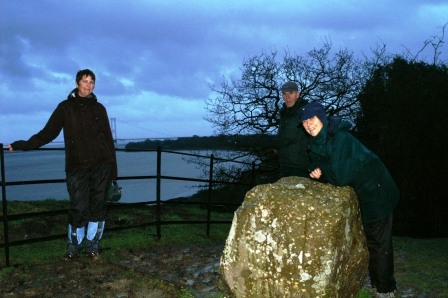Walking the Offa's Dyke Path
Day One: Trial by Rain

Chepstow Castle in Wales
Mary, Julia, David, and Ernest embarked on their journey, driving 186 miles across England from Canterbury in Kent to Chepstow in Wales. It was Monday, January 21, 2008, and rain poured relentlessly throughout the four-hour drive—coincidentally almost the same distance they would be hiking on Offa's Dyke Path over the next six days.
After settling into their rustic pub, they walked to the start (or finish) of Offa's Dyke Path at the River Wye. The rain continued, the wind howled, and the sky loomed dark, but they pressed on. Ernest was the first to slip in the mud—twice—much to everyone's amusement, except his own. As they trudged forward, each of them would soon have their own muddy mishaps before the journey was over.

Start/finish of the Offa's Dyke Path
That evening, they eagerly anticipated a hearty British breakfast—sausages, eggs, mushrooms, and fried bread—to fuel them for the trek ahead. Locals in the pub warned of more rain, potential landslides, and even snow in the coming days.
Despite the gloomy weather, they took time to explore Chepstow Castle, perched atop cliffs overlooking the River Wye. Built between 1067 and 1300, it is Britain's oldest surviving stone fortification—an architectural masterpiece that echoes both the beauty and brutality of history.
.JPG)
The start of the southern end of the path
William the Conqueror quickly established Chepstow Castle due to its strategic significance. Before the Norman invasion, no settlements existed in this area. However, the River Wye served as a vital crossing point for travelers from Monmouth and Hereford. At the time, the Welsh kingdoms remained independent of English rule, and the castle played a crucial role in suppressing Welsh resistance.
That night, the sound of rain pounded against the roof as the group drifted to sleep. What would tomorrow bring? More rain? Snow? Only time would tell.
Join me in the next installment of Walking the Offa's Dyke Path.